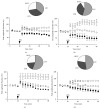Age-related alterations in the expression of genes and synaptic plasticity associated with nitric oxide signaling in the mouse dorsal striatum
- PMID: 25821602
- PMCID: PMC4364378
- DOI: 10.1155/2015/458123
Age-related alterations in the expression of genes and synaptic plasticity associated with nitric oxide signaling in the mouse dorsal striatum
Abstract
Age-related alterations in the expression of genes and corticostriatal synaptic plasticity were studied in the dorsal striatum of mice of four age groups from young (2-3 months old) to old (18-24 months of age) animals. A significant decrease in transcripts encoding neuronal nitric oxide (NO) synthase and receptors involved in its activation (NR1 subunit of the glutamate NMDA receptor and D1 dopamine receptor) was found in the striatum of old mice using gene array and real-time RT-PCR analysis. The old striatum showed also a significantly higher number of GFAP-expressing astrocytes and an increased expression of astroglial, inflammatory, and oxidative stress markers. Field potential recordings from striatal slices revealed age-related alterations in the magnitude and dynamics of electrically induced long-term depression (LTD) and significant enhancement of electrically induced long-term potentiation in the middle-aged striatum (6-7 and 12-13 months of age). Corticostriatal NO-dependent LTD induced by pharmacological activation of group I metabotropic glutamate receptors underwent significant reduction with aging and could be restored by inhibition of cGMP hydrolysis indicating that its age-related deficit is caused by an altered NO-cGMP signaling cascade. It is suggested that age-related alterations in corticostriatal synaptic plasticity may result from functional alterations in receptor-activated signaling cascades associated with increasing neuroinflammation and a prooxidant state.
Figures







Similar articles
-
Impaired novelty acquisition and synaptic plasticity in congenital hyperammonemia caused by hepatic glutamine synthetase deficiency.Sci Rep. 2017 Jan 9;7:40190. doi: 10.1038/srep40190. Sci Rep. 2017. PMID: 28067279 Free PMC article.
-
Pre- and postsynaptic contributions to age-related alterations in corticostriatal synaptic plasticity.Synapse. 2006 Sep 1;60(3):223-38. doi: 10.1002/syn.20289. Synapse. 2006. PMID: 16739119
-
Glutamate regulation of DARPP-32 phosphorylation in neostriatal neurons involves activation of multiple signaling cascades.Proc Natl Acad Sci U S A. 2005 Jan 25;102(4):1199-204. doi: 10.1073/pnas.0409138102. Epub 2005 Jan 18. Proc Natl Acad Sci U S A. 2005. PMID: 15657149 Free PMC article.
-
Asymmetric spike-timing dependent plasticity of striatal nitric oxide-synthase interneurons.Neuroscience. 2009 Jun 2;160(4):744-54. doi: 10.1016/j.neuroscience.2009.03.015. Epub 2009 Mar 19. Neuroscience. 2009. PMID: 19303912
-
Glutamate-mediated plasticity in corticostriatal networks: role in adaptive motor learning.Ann N Y Acad Sci. 2003 Nov;1003:159-68. doi: 10.1196/annals.1300.061. Ann N Y Acad Sci. 2003. PMID: 14684443 Review.
Cited by
-
Impaired novelty acquisition and synaptic plasticity in congenital hyperammonemia caused by hepatic glutamine synthetase deficiency.Sci Rep. 2017 Jan 9;7:40190. doi: 10.1038/srep40190. Sci Rep. 2017. PMID: 28067279 Free PMC article.
-
Long-term HIV-1 Tat Expression in the Brain Led to Neurobehavioral, Pathological, and Epigenetic Changes Reminiscent of Accelerated Aging.Aging Dis. 2020 Feb 1;11(1):93-107. doi: 10.14336/AD.2019.0323. eCollection 2020 Feb. Aging Dis. 2020. PMID: 32010484 Free PMC article.
-
An Overview of NO Signaling Pathways in Aging.Molecules. 2021 Jul 27;26(15):4533. doi: 10.3390/molecules26154533. Molecules. 2021. PMID: 34361685 Free PMC article. Review.
-
The Influence of Na(+), K(+)-ATPase on Glutamate Signaling in Neurodegenerative Diseases and Senescence.Front Physiol. 2016 Jun 2;7:195. doi: 10.3389/fphys.2016.00195. eCollection 2016. Front Physiol. 2016. PMID: 27313535 Free PMC article. Review.
-
Repairing the Aged Parkinsonian Striatum: Lessons from the Lab and Clinic.J Clin Cell Immunol. 2016 Dec;7(6):476. doi: 10.4172/2155-9899.1000476. Epub 2016 Dec 6. J Clin Cell Immunol. 2016. PMID: 28111608 Free PMC article.
References
-
- Langenecker S. A., Briceno E. M., Hamid N. M., Nielson K. A. An evaluation of distinct volumetric and functional MRI contributions toward understanding age and task performance: a study in the basal ganglia. Brain Research. 2007;1135(1):58–68. doi: 10.1016/j.brainres.2006.11.068. - DOI - PMC - PubMed
Publication types
MeSH terms
Substances
LinkOut - more resources
Full Text Sources
Other Literature Sources
Medical
Miscellaneous

